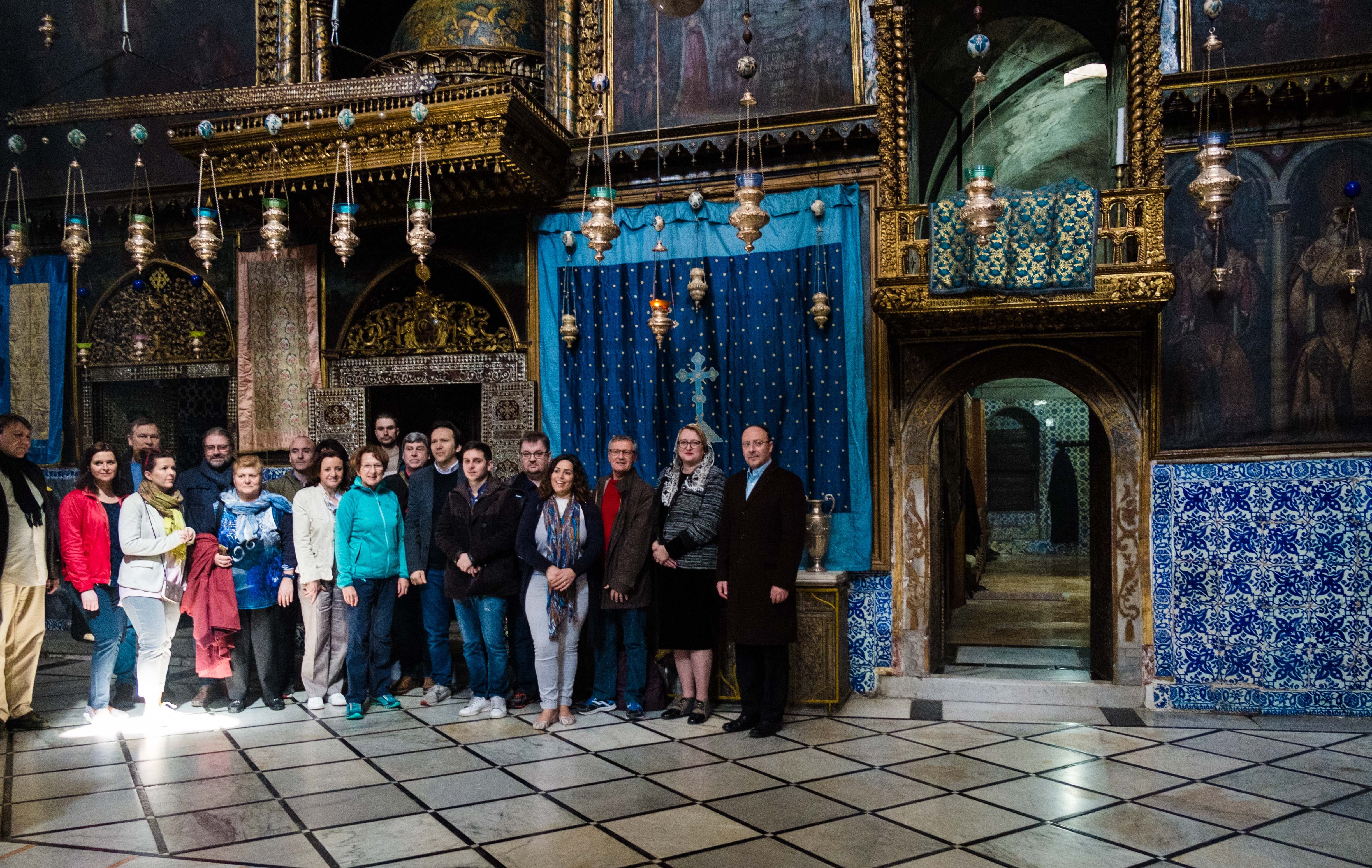
Delegation of the European St. James Way visits St. James Cathedral in Jerusalem

Armenian Apostolic Orthodox Patriarchate of Jerusalem – 26/3/18
Saturday morning March 10, a delegation of the Fédération Européenne du Saint-Jacques de Compostelle visited the Armenian Convent of St. James.
Their visit was well prepared by correspondence as well as a previous visit of M. Gérard Beaume, the general coordinator of the Fédération. The delegation consisted of about 25 people of the organisation, led by the president Mr. Simone Pettirossi of the city of Assisi.
The pilgrimage to St. James of Compostella, or the Saint James Way, is the main pilgrimage route in Europe, and has two permanent representatives in the Council of Europe.
According to Christian tradition the Apostle St. James preached the Gospel till in Spain, and returned for some time to the Holy Land. The book of Acts tells us that king Herod Agrippas I “killed James the brother of John with the sword” (Acts 12:2). The head of St. James was buried in Jerusalem, and his body in Spain. The location in Jerusalem (now in St. James Cathedral) is known since then; the exact burial place of St. James’s body in Spain however remained unknown until the 9th century.
In the beginning of the 9th century, the hermit Pelagos who lived in Spain, saw lights or stars blinking above a certain place- where a marble coffin with the relics of St. James were found. The name “Compostella” according to popular etymology, comes from the Latin Campus Stellae, field of stars- referring to the stars the monk Pelago saw above St. James’s relics.

Relics of St. James in Santiago de Compostela, Spain
The Spanish king Alphonso II travelled to that location, and had a church built on the site. King Alphonso II is seen as the first pilgrim to Santiago de Compostela.
The modest sanctuary in Santiago drew many pilgrims, but the church was too small for the enormous numbers of pilgrims from Europe. The church of Santiago was therefore enlarged and embellished. The city of Santiago also benefited from becoming one of the most important pilgrimage sites in Europe, and grew to a center of universities, trade and visitors.

The famous symbol of the scallop shell, ( Coquille St. Jacques, Jakobsmuschel) is native to the coast of Galicia in Spain, and was therefore a visible sign that the bearer had travelled to Santiago de Compostela.
Also in our days, the Way of St. James remains the most popular pilgrimage within Europe, with various routes from all over Europe leading to Santiago.

Since early times pilgrims to Santiago also visited the Armenian Cathedral of St. James in Jerusalem.The visit of Fédération Européenne du Saint-Jacques de Compostelle or Saint James Way intends to renew and revive the ancient relations between the two St. James pilgrimage sites. The delegation of the Saint James Way visited the Armenian St. James Cathedral and the Monastery of Saint James.

Deacon Rafael Ghazarian told the delegates about the manuscript collection in St. Toros Library. After that His Eminence Archbishop Sevan Gharibian, the Grand Sacristan of the Armenian Patriarchate in Jerusalem, met with the delegates. The members of the Saint James Way brought gifts with them for His Eminence. His Eminence spoke words of thanks, and expressed good hope for continuation of the contacts and cooperation, which was confirmed by the delegation.
Pictures in Jerusalem: Dr. Claudia Venhorst

87721 904523bathroom towels need to be maintained with a very good fabric conditioner so that they will last longer:: 297250
459488 988537Great V I should definitely pronounce, impressed with your web site. I had no trouble navigating through all the tabs as well as related information ended up being truly simple to do to access. I recently found what I hoped for before you know it at all. 55909